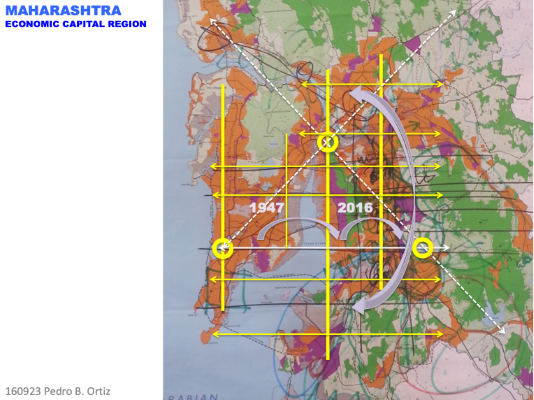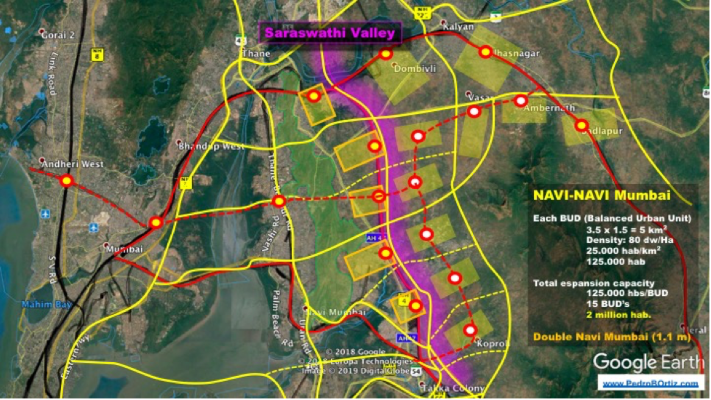-
CENTRES
Progammes & Centres
Location
Mumbai must spearhead the positioning of India as the third economic superpower, in between the forecasted East/West civilisation confrontation.

This article is part of the series — What to Expect from 2021.
Mumbai is at the centre of the COVID-19 fight in India. The megapolis, which is grappling with high population density, low annual economic growth and sparse land availability, must think differently on its path ahead in the post-COVID-19 space. It is time to reimagine Mumbai by creating new urban metropolitan centralities to bring in international competitiveness and a better quality of life.
Sample this. Mumbai is growing — but not too much — at an annual 2 percent. That is both bad and good. Bad, because it means that Mumbai is not attractive enough to be the aim of immigration. Its economy is not working as it could and there are other metropolises in India, some close to Mumbai, that are more attractive and are growing faster. Pune, for instance, is growing at close to 10 percent annual. Good, because a 2 percent growth is easier to manage.
Mumbai is growing — but not too much — at an annual 2 percent.
At a 2 percent annual growth rate, the city brings in 4,60,000 new inhabitants annually, which is about 100,000 families, who need 100,000 dwellings. To cater to this, the city will need to provide for over 10 square kilometre of land annually for residential purposes, assuming a space of 1 kilometre can accommodate about 30,000 people.
Mumbai does not have the land to support this. Seven decades ago, the decision to jump the city across the bay was made precisely to deal with this issue. Navi Mumbai (New Mumbai) was created and has been a success. It is time to look further and create an extension to Navi Mumbai as a set of urban centralities, parallel to the Navi Mumbai ones, beyond the east hills that refrain expansion — the Navi Navi Mumbai (a New-New Mumbai), which will be part of the Mumbai Metropolitan Region (MMR).
The MMR, which s over 6500 square kilometres and over eight municipal corporations and eight councils, has a geographical setting built on parallel lines. These lines consist of the coast, coastal hills, bay green, bay, Navi Mumbai plain, inland hills, inland valley, plateau foothills and Indian plateau. This connectivity is primarily a north-south one, which will be needed to be stitched together with the east-west. While bridges were built across the bay to get to Navi Mumbai, the new version will need to be created through green and grey corridors. The Intergovernmental Panel on Climate Change report, released in 2018, suggests that coastal megacities like Mumbai are particularly vulnerable to global warming. This will become an important consideration in the post-COVID-19 world, which will need to look at alternative solutions for sustainable growth.


This reticular pattern to the east will support an important stock of residential units, Balanced Urban Development (BUD), that will provide for all urban necessary functions. Beyond the first line of the BUD, the north-south metropolitan freeway will provide the best accessible and affordable location of high-tech ITC firms that will have a direct link to the new airport and will put Mumbai in a global competitive market it needs to harness, the Saraswathi Corridor. The accumulation of these logistic infrastructures provides substantial potential for developing a global platform for innovation, research and high-tech solutions. What this centrality will do is add value to Mumbai’s strategic objective. Knowledge cities, and research and technology hubs may emerge, giving competition to the Silicon Valley.
All primary socio-administrative, commercial, offices and urban open spaces can be created on urban centralities, and will generate a balance pattern of traffic, commuting trips and jobs.
The proposed Navi-Navi Mumbai development should be initiated by cheaply extending the transport lines that feed Navi Mumbai with a set of intermodal stations. All primary socio-administrative, commercial, offices and urban open spaces can be created on these urban centralities, and will generate a balance pattern of traffic, commuting trips and jobs.
Only with these developments will Mumbai be able to join world metropolises and take its position as India’s leading metropolis. Mumbai must spearhead the positioning of India as the third economic superpower, in between the forecasted East/West civilisation confrontation. This is a role the world needs India to play, but this cannot happen without Mumbai, and certainly not unless the city adopts adequate metropolitan policies.
Dr Pedro Ortiz is an urban/metropolitan planner, consultant to international institutions, including the European Union and the Indian government. He is Principal of the International Metropolitan Institute.
The views expressed above belong to the author(s). ORF research and analyses now available on Telegram! Click here to access our curated content — blogs, longforms and interviews.